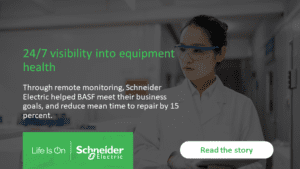This is Part 1 of the series: The Future of Field Services Is Here.

The future of field services is here, and the new outcome-based services model looks quite different than the traditional break/fix model you may be used to.
Historically, field services has been a reactive industry. When an equipment issue arises, a site manager requests assistance from a services organization, and then a field service representative arrives at the site to repair or replace the damaged equipment.
But this traditional service model no longer meets the needs of customers, who often require more than just a quick fix.
A majority of services customers today, across virtually every industry, now want support to enhance their operations and meet their business goals.¹ And, thanks to the data generated from connected operational technology (OT), field services is poised to deliver these results.
In this post, I walk through the transition from a traditional to an outcome-based services model, and address how this evolution more effectively meets your customer’s needs.
Two catalysts for the outcome-based services evolution
Two macro-level changes in the electrical industry are fueling the evolution of field services to an outcome-based services model.
One of the most significant factors is the personnel crisis. As a whole, the electrical industry has an aging workforce, and the employees hired to replace retirees aren’t coming in with the institutional knowledge held by previous generations. This skills gap is fundamentally changing how organizations operate and what tasks they need to outsource to field services.
And then there’s digital transformation. The sheer amount of data OT generates is significant and game-changing. Armed with this data, organizations can take measures to improve day-to-day operations and meet their business goals — higher uptime, increased production rates, decreased energy use, etc. Yet, 77 percent of respondents in a ServiceMax study indicated that the pace of data intelligence digitally collected by their assets is outpacing the skills of those responsible for using the data.
To be blunt, many companies simply don’t have the capacity to manage their own data, let alone use it to improve their outcomes. On the other hand, field services companies are actively training field service representatives in these IT skillsets to prepare for this digital future.

Why outcome-based services are also customer-centric
Field services is positioned to meet these new customer needs by moving beyond traditional operations and maintenance to outcome-based services.
The outcome-based model involves servicing OT throughout the entire product lifecycle and using data generated from that equipment to help customers meet their goals. Instead of calling on field services as problems arise, the customer would partner with a services company to install connected products, monitor asset health, and make recommendations to optimize operations. The customer doesn’t need to hire or train new employees to get these results — it relies solely on the services provider.
Let’s say a customer wants to improve the energy efficiency of their facility. With this new service model, field services would monitor their facility, use that data to analyze energy usage, and then develop and implement a plan to optimize the building’s systems and predict potential issues for greater energy savings. If a problem were to arise that impacted the customer’s energy efficiency, such as an overheated transformer, services takes responsibility for all actions and expenses (e.g., labor, tools, etc.) related to the fix.
At the core of this outcome-based model lies digitization. Without connected devices generating data, and cloud and on-premise monitoring, it would be much more difficult for field services to guarantee these results.
In the right hands, data helps businesses meet their goals
Every company has its own set of goals, which is why every outcome-based services contract looks different. For example, Schneider Electric™ is partnering with BASF to help them reach their business goals of higher uptime and productivity at their power substation in Beaumont, Texas.
By remotely monitoring connected assets throughout the facility using EcoStruxure™ Asset Advisor, our services team gets 24/7 visibility into the electrical distribution equipment’s health and efficiency. And, with this data, we provide BASF with customized advice and proactive recommendations to help prevent equipment failure and optimize maintenance strategies, thus meeting their pre-determined business goals.
Since the beginning of our partnership, BASF has met its intended outcomes, including decreasing the mean time to repair equipment by 15 percent and increasing the mean time between planned outages by 20 percent.

From break-fix to goal-based services
No longer is field services just a break-fix solution. The industry is now a provider of proactive and preventive strategies to help customers struggling with personnel challenges meet their business goals.
To learn more about the ways we use remote services for preventive and corrective maintenance, read our blog: Remote services offers a dose of telemedicine for your critical facility’s electrical equipment.
In Part 2 of the series: The Future of Field Services is Here, I discuss the evolution of the field service representative.
Click here to read Part 2: What does the field representative of the future look like?



